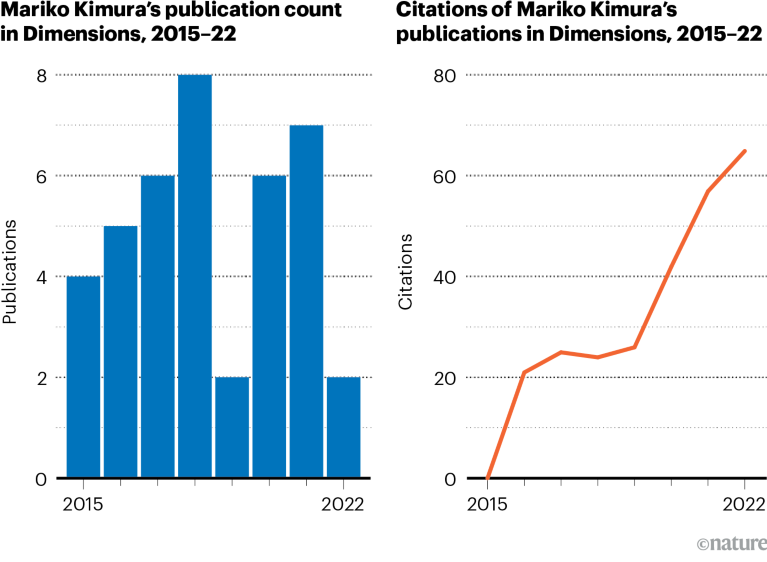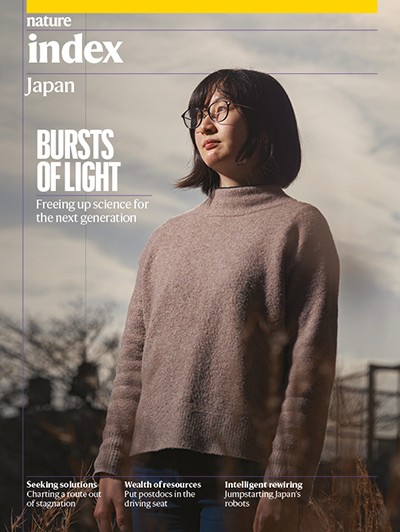
Mariko Kimura plans to shift her focus to γ-ray bursts, and hopes her work will inspire other women in astronomy.Credit: Irwin Wong for Nature
This is the first in a Nature Index series of profiles about emerging early-careers researchers in Japan.
About 370 years ago, something odd happened in the binary star system SS Cygni. Normally, the interactions between the two stars that make up SS Cygni mean that it cyclically gets brighter and dimmer every month or so, but for some reason this variation stopped for a short while. When the light from that anomaly finally reached Earth in 2021, Mariko Kimura was watching.
Kimura, an astronomer at the RIKEN Cluster for Pioneering Research in Saitama, Japan, uses both ground-based optical telescopes and satellite X-ray telescopes to make sense of signals from variable stars, black holes and other celestial phenomena. “Many people think stars and galaxies are constant and burn eternally, but there are unexpected events that only astronomers like me and my co-workers can see,” she says.
Nature Index 2023 Japan
She spends much of her time looking at binary black holes, systems in which two black holes closely orbit each other. Some black holes are encircled by a swirling mass of gas and other matter, known as accretion discs, that are caught up in the intense gravity. The super-heated inner bands of these discs glow with X-rays, which is why X-ray telescopes are an important tool for astronomers hunting for black holes, Kimura explains.
But X-rays aren’t the only signal from those spots of intense gravity. As reported in a 2016 paper in Nature1, Kimura and her team were able to detect a burst of visible light from the accretion disc of V404 Cygni, a black hole more than 2,450 parsecs (8,000 light years) away. V404 Cygni has the mass of about nine Suns and is intermittently growing by consuming a companion star. The burst of light provided insights into the flow of mass from the star to the black hole, but they also underscored the potential to find and track black holes with optical telescopes. Kimura says that even amateur astronomers with higher-end telescopes could see the light signal from V404 Cygni if they knew where to look.
Amateur astronomers have much to contribute to space science, Kimura says. The first hints that something unusual was happening at SS Cygni came from a network of amateurs and professionals who watch for anomalies in the night sky and upload their findings to a database. Once alerted, Kimura was able to guide the 3.8-metre SEIMEI telescope at the Okayama Astrophysical Observatory to focus in on the target.
Kimura and her co-author proposed a possible explanation for the abnormal light patterns from SS Cygni in a 2023 paper2. They suspect that an overflow of gas escaping from one of the stars in the binary system to the other distorted the view. Kimura says she’s inspired by the ways that observed light can illuminate the physics of distant objects. “Prior to this work, astronomers had not considered that overflow occurs in this system,” she says.

Source: Dimensions
Kimura, who moved her office to Kanazawa University in 2022, is planning to shift her attention to γ-ray bursts, violent eruptions of energy that can signal the birth of a black hole after the death of a massive star. Although her colleagues closely monitor the bursts with γ-ray telescopes, she plans to use the SEIMEI telescope as well as X-ray telescopes to get a different view. She says she’s never observed the creation stage of a black hole, but she believes her previous work will serve her well. “The observational strategy is similar,” she says.
Kimura’s insights are getting attention. In 2022, she was awarded the Inspiration Prize in the Japan Science and Technology Agency’s first Marie Skłodowska Curie Awards, set up to recognize early-career female researchers.
Kimura hopes that her work can be a source of inspiration to other women in astronomy. “Some female students have trouble in their work or their interactions with professors, and they talk to me,” she says. “I tell them about my experiences. I hope it’s helpful.”
It’s important to encourage women to enter the field, she says, because COVID-19 seems to have deepened astronomy’s gender imbalance globally. A 2022 analysis of publishing trends in the field showed that the fraction of papers written by female astronomers has fallen compared with pre-pandemic levels3. In the big picture, she says, it’s an exciting time to be an astronomer. “Telescopes are developing,” she says. “We have many devices to observe black-hole binaries and distant galaxies. I’m very excited about unknown things.”
This article is part of Nature Index 2023 Japan, an editorially independent supplement. Advertisers have no influence over the content.


